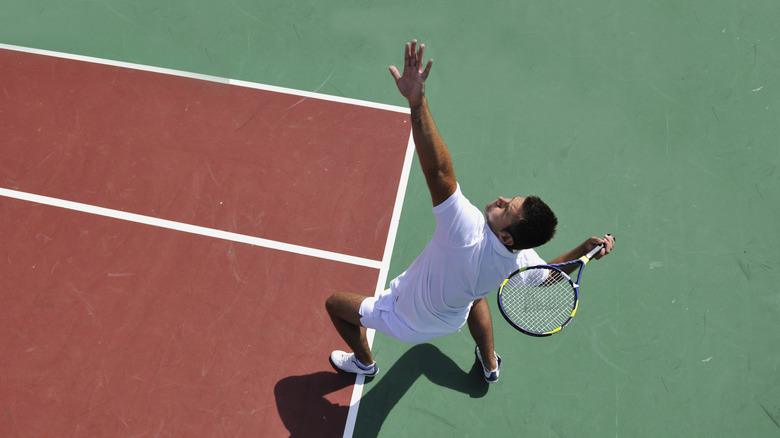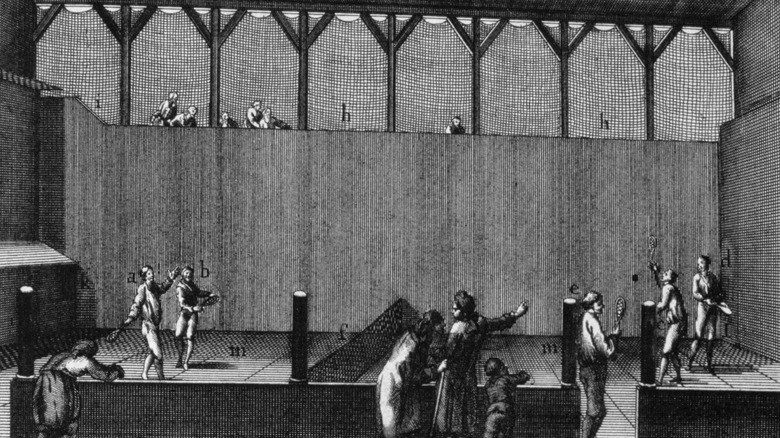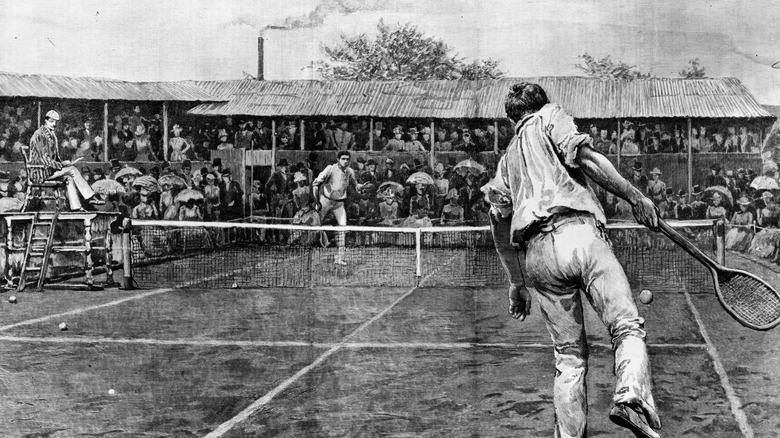Is This Why A Score Of Zero Is Called Love In Tennis?
Any sport can seem confusing and unnecessarily complicated to an outside observer. Cricket, for example, breaks anyone's brain who isn't a huge fan of it already: games that go on for days, players running back and forth between two sets of posts, and a scoring system that makes little to no sense to people who don't hail from corners of the world where cricket is a popular mainstream sport. Similarly, American football's scoring system can have the same effect where it's not a major part of the sporting landscape.
Another sport with a scoring system that makes zero sense — even to a lot of its players and fans — is tennis. Hearing the point system in tennis goes love, 15, 30, and then 40, is sure to draw quizzical looks from anyone being introduced to the game, their head cocking to the side by about 45 degrees like a perplexed German shepherd. They'll often ask why the point value changed from 15 to 10, but the truth of the matter is that it's best to just accept that this is tennis' reality. Don't hurt yourself trying to understand it.
Tennis has been scored essentially the same way system since it was introduced in Victorian England, per Time, so it's safe to say that the game's unusual scoring system — including the use of the word "love" instead of zero or nothing — is here to stay.
The origins of tennis go back a long way
Tennis as it's known today can be traced way back to 12th and 13th century France. At the time, a game was developed that became known as jeu de paume, which in English means game of the palm (via Britannica). The game was initially played with a bare hand instead of a racquet, and that's where it got its name. It became popular in the south of France, worked its way north, and by the 1300s it was one of the country's most popular games.
Jeu de paume wasn't reserved for any particular class of people (via Smithsonian). While it started out being played by villagers and monks, by the time it achieved massive popularity people from all walks of life played. At its peak, there were more than 7,000 active players in Paris alone who took to the city's 250 or so courts to compete.
This early version of tennis is still played today, though it's not nearly as common — even in France where it originated — as it was hundreds of years ago. There are only three playable courts left in all of France. Some of the jeu de paume courts still around in Paris today carry historical significance. One of them is just outside of Paris, at Fontainebleau, a home that can count both King Henri IV and Napoleon as past residents.
Tennis also has roots in England
When jeu de paume migrated across the English Channel, it started to morph into a sport more reminiscent of modern tennis. Jeu de paume was usually played in courtyards with balls fashioned out of wood. Eventually, indoor courts became the favored venue and a new ball was introduced, made out of leather, much bouncier, and a clear precursor to modern tennis balls (via History).
This iteration became known as real tennis, and it was played indoors on walled, hard-floored courts. The ball could be played off the walls and points were scored by hitting the ball into pockets just below the ceiling. There was a net separating the court, but unlike modern nets, which have a consistent height the entire way across, these were five tall on the ends, but only three feet tall in the middle, which gave it a curved or sagging appearance.
The game started to decrease in popularity in the 1700s, but with the advent of vulcanized rubber in the 1800s, real tennis saw a resurgence. The new, bouncier balls also allowed for play on grass, which is what led to lawn tennis, the version of the game most people think of when they think of tennis.
Modern tennis made its debut at Wimbledon
Tennis as we know it — save for a handful of small changes — made its debut in Lonon in 1877. The All England Club Croquet held the first iteration of the Wimbledon tournament using rules that had been developed several years earlier by Major Walter C. Wingfield for a game called Sphairistike, which is a Greek word that means playing at ball.
According to History, Wingfield's game used an hourglass-shaped court, but the Wimbledon organizers decided to use a rectangular court typically utilized for croquet instead. The rules they used for that first tournament — which was actually a fundraiser for the club — are essentially the same that are used today, and Wimbledon has gone on to become one of the preeminent tennis tournaments in the world. Even back then, players used a version of the mysterious scoring system that has become ingrained in the sport, but still befuddles most people.
The history of tennis scoring
According to Time, the unusual scoring system of tennis goes back about as far as the game's history does, though there were occasional differences. One of the early scoring systems used 15, 30, then 45 points, increments of 15 that make a little bit more sense than the modern system. Some have hypothesized that this came from the minutes on a clock. However, that explanation doesn't explain why the modern game uses 40 instead of 45.
All sports have their own set of slang terms that develop over the years, and tennis is no different. It's believed that this is the reason why the scoring system dropped 5 points, because saying "forty" is marginally faster than saying "forty-five." This change didn't change anything other than making things a little more confusing. However, In the grand scheme of things, tennis is a bit like "Whose Line Is It Anyway?" in that the point values don't matter as they don't change the system. It has almost always been possible to simplify it down to 0, 1, 2, and 3.
Why does love mean zero?
There are some different explanations for why the word love is used in tennis instead of zero or nothing. It's where both players start a game, and where less-adept players often stay. That's why one explanation is that someone with zero points is playing for "the love of the game" (via Merriam-Webster).
Another explanation goes back to the game's earliest roots in France. There's a vowel in French with no exact English equivalent, known as l'œuf. However, the best approximation is that l'œuf could be pronounced in English as something along the lines of lerf or luff. Additionally, the French word œuf means egg. Seeing as eggs bear a resemblance to the number zero, it's thought the French may have used l'œuf to mean zero. It's another example of a sport's players developing a unique set of slang terms or shorthand. Even today, the term "goose egg" is a common way of saying a player doesn't have any points. When the game made its way across the English Channel, English ears heard l'œuf as love, and simply never bothered to change it.





